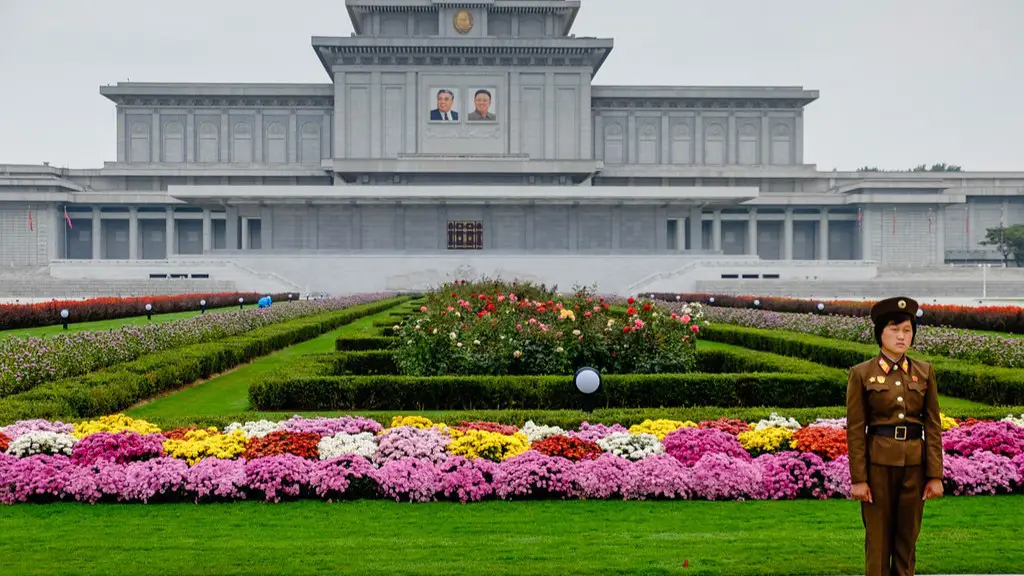Since the 1950s, North Korea has been a thorn in the side of the United States. Its nuclear program has been a major concern for American policymakers, and North Korea’s human rights record is among the worst in the world. In recent years, North Korea has made significant progress in its nuclear program, and its leader, Kim Jong-un, has been increasingly belligerent in his rhetoric towards the United States. This has led some to believe that North Korea is a serious threat to the United States and its interests in the region.
There is no one-size-fits-all answer to this question, as the level of threat North Korea poses to the United States depends on a number of factors, including the current political situation, the strength of the North Korean military, and the country’s ability to develop and deploy nuclear weapons. However, some experts believe that North Korea does pose a significant threat to the United States, particularly if the country is able to develop a working nuclear weapon.
When did North Korea threaten the US?
It is clear that North Korea is not happy with the United States and its recent actions. On March 29, 2013, Kim Jong-un threatened the United States by declaring that rockets were ready to be fired at American bases in the Pacific. This declaration was in response to two B2 stealth bombers that flew over the Korean peninsula on the day before. It is important to remember that North Korea has the capability to back up these threats with real action. The United States should take these threats seriously and be prepared to respond accordingly.
The Democratic People’s Republic of Korea, better known as North Korea, has long been a source of concern for the international community due to its nuclear weapons program. In recent months, Pyongyang has escalated its nuclear threats and has threatened an “unprecedentedly” strong response to annual US-South Korea military drills, which it views as preparation for an invasion. This has led to increased tensions in the region and has raised the possibility of a military conflict. The international community must continue to work together to find a peaceful resolution to the North Korean crisis.
Can North Korea missiles reach the US
North Korea has demonstrated that it has missiles that could fly far enough to reach deep into the continental US, but it’s not clear whether they can survive re-entering the Earth’s atmosphere on arrival. If North Korea is able to successfully develop ICBMs, it would pose a serious threat to the US and its allies.
North Korea’s long-range missile and nuclear programs represent the region’s most immediate security challenge. Any major instability or conflict on the Korean Peninsula would have severe strategic, economic and humanitarian repercussions. The international community must continue to work together to address this challenge and ensure peace and stability in the region.
How much of North Korea did the US destroy?
The devastation caused by conventional weapons during the campaign was unprecedented. Nearly all of the country’s cities and towns were destroyed, and an estimated 85 percent of its buildings were destroyed. This resulted in a massive humanitarian crisis, with millions of people displaced and in need of assistance.
The U.S. Department of State continues to warn U.S. citizens not to travel to North Korea due to the serious risk of arrest and long-term detention. U.S. citizens in North Korea are at risk of becoming victims of arbitrary arrest and detention. There have been reports of North Korean authorities arbitrarily arresting and detaining U.S. citizens without charges or due process. The North Korean government has also been known to detain foreigners with the intent to use them as bargaining chips in future negotiations with the United States or other countries.
How long would it take for a nuke to reach the US?
It’s important to remember that the time it would take for a land-based missile to travel between Russia and the United States is significantly different than the time it would take for a submarine-based missile. A land-based missile would likely take around 30 minutes to make the journey, while a submarine-based missile could reach its target in as little as 10-15 minutes. This difference is due to the fact that a submarine can travel much faster than a land-based vehicle.
Yes, it is possible to shoot down a nuclear missile. However, it is very difficult to do so and requires a lot of planning and coordination. There are a limited number of anti-missile systems in the world that are capable of intercepting an ICBM, and they are very expensive. In order to shoot down a nuclear missile, you would need to have a very good understanding of its trajectory and plan your attack accordingly.
How far can a nuclear bomb travel
The air blast from a nuclear detonation can cause serious injuries and even death from flying glass shards. The radius of the blast increases with the size of the bomb, so a 10 KT bomb could cause fatalities up to 03 miles away. The blast can also cause fires and other damage.
The Hwasong-14 ballistic missile is a North Korean intercontinental ballistic missile that is capable of reaching the US island of Guam in the Pacific, as well as the US city of New York. The missile has a range of 8,000km, but some studies suggest it could travel as far as 10,000km.
Can the US shoot down incoming missiles?
The United States deploys two systems that can shoot down incoming missiles in the midcourse phase of flight: The Ground-Based Midcourse Defense (GMD) system and The Aegis defense system.
The Ground-Based Midcourse Defense (GMD) system is a network of radars, sensors, and ground-based interceptor missiles located in Alaska and California. This system is designed to intercept long-range ballistic missiles in the midcourse phase of their flight.
The Aegis system is a network of sea-based radars and missiles that can be deployed on land or at sea. This system is designed to intercept shorter-range ballistic missiles in the midcourse or terminal phases of their flight.
The New START treaty was signed between the United States and Russia in April 2010 in an effort to reduce both countries’ nuclear arsenals. The treaty limited each country to 1,550 nuclear warheads “loaded onto an intercontinental-range ballistic missile that can reach the United States in approximately 30 minutes.”
The treaty was set to expire in 2021, but in October 2020, the United States and Russia agreed to extend the treaty for five years, through February 2026.
Both the United States and Russia are signatories of the Non-Proliferation of Nuclear Weapons treaty, which was first signed in 1968.
Who are North Korea’s allies
China and North Korea have a long and close relationship. This is largely due to their shared border, and their mutual aid and co-operation treaty. Currently, China is North Korea’s closest ally.
Russia has the most confirmed nuclear weapons, with 5,997 nuclear warheads. The United States follows behind with 5,428 nuclear weapons, hosted in the US and 5 other nations: Turkey, Italy, Belgium, Germany and the Netherlands. Modern nuclear arsenals are significantly smaller than their peak during the Cold War, when the US and the Soviet Union had roughly 30,000 nuclear weapons each.
How powerful is North Korea army?
North Korea’s military is large but its equipment is old and it lacks supplies. It has turned to nuclear weapons to try to make up for its shortcomings.
The Korean War was a conflict that emerged after World War II. On June 27, 1950, the United States officially entered the Korean War. The US supported the Republic of Korea (commonly called South Korea), in repelling an invasion from the Democratic People’s Republic of Korea (commonly called North Korea). The Korean War was a significant event in the Cold War, and demonstrated the inability of the US to contain the spread of Communism.
Was the US winning the Korean War
The Korean War is often referred to as a “Forgotten War.” Nevertheless, it was a significant conflict with far-reaching consequences. The war began on June 25, 1950, when the North Korean People’s Army invaded South Korea. The United States quickly became involved, providing military and economic aid to the South Koreans. Although the war ended where it began, in Korea, the United States and its allies did succeed in preventing communism from overtaking South Korea. The war also led to a major expansion of the U.S. military, which remained stationed in South Korea for many years afterwards.
According to US intelligence officials, prime minister Benazir Bhutto of Pakistan allegedly supplied key data, stored on CDs, on uranium enrichment and information to North Korea in exchange for missile technology around 1990–1996. This data is said to have helped North Korea develop its nuclear weapons program. If true, this would constitute a major breach of international law and a serious threat to global security.
Conclusion
North Korea is a potential threat to the United States because it possesses nuclear weapons and has a history of aggression.
There is no easy answer to the question of whether or not North Korea is a threat to the United States. On the one hand, the country does have a history of aggression and its nuclear program is a major concern. On the other hand, North Korea has shown some willingness to negotiate and its military capabilities are not as sophisticated as some other nations. Ultimately, the decision of whether or not North Korea is a threat to the United States is a complex one that requires careful consideration.





